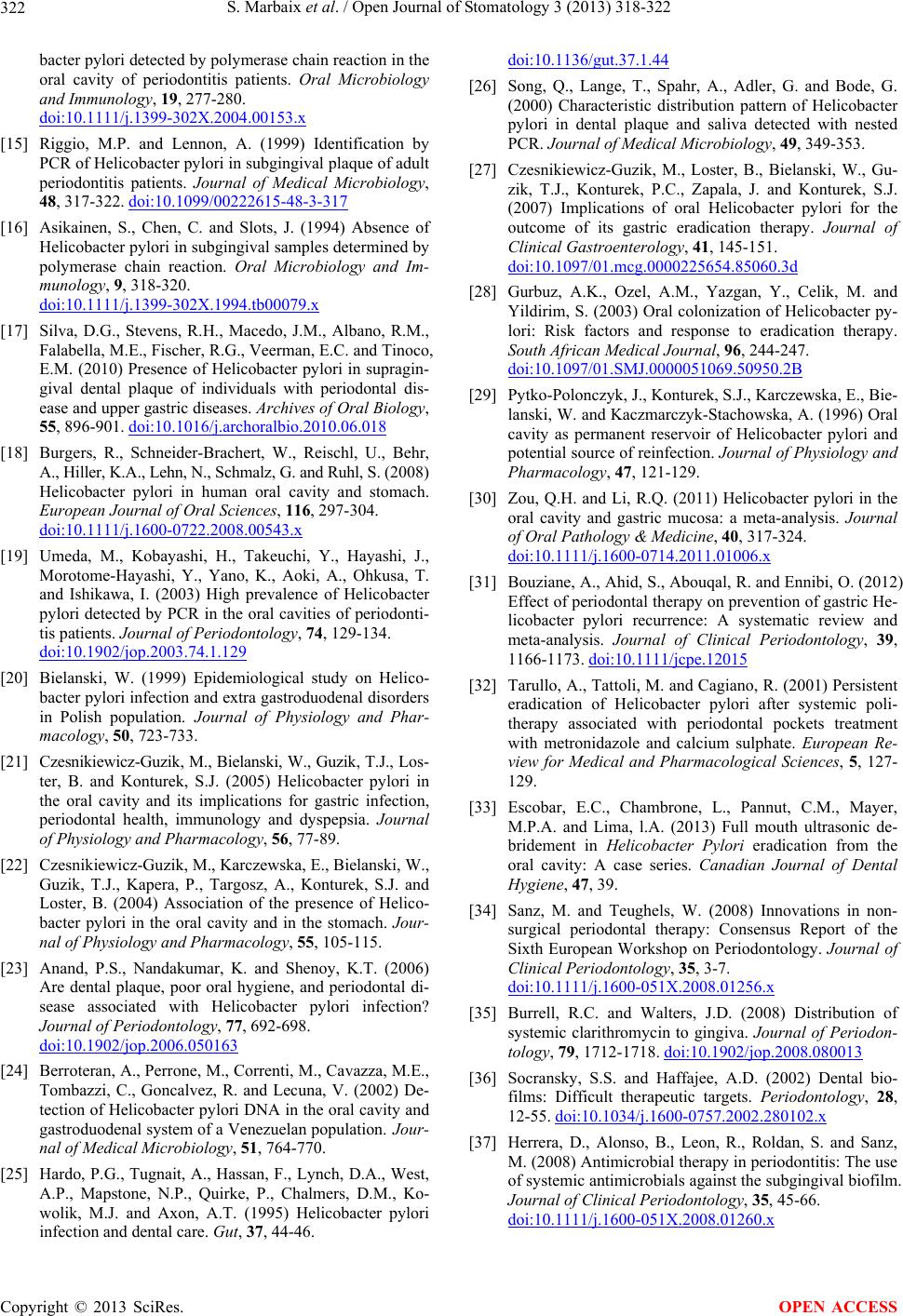
S. Marbaix et al. / Open Journal of Stomatology 3 (2013) 318-322
Copyright © 2013 SciRes.
322
OPEN ACCESS
bacter pylori detected by polymerase chain reaction in the
oral cavity of periodontitis patients. Oral Microbiology
and Immunology, 19, 277-280.
doi:10.1111/j.1399-302X.2004.00153.x
[15] Riggio, M.P. and Lennon, A. (1999) Identification by
PCR of Helicobacter pylori in subgingival plaque of adult
periodontitis patients. Journal of Medical Microbiology,
48, 317-322. doi:10.1099/00222615-48-3-317
[16] Asikainen, S., Chen, C. and Slots, J. (1994) Absence of
Helicobacter pylori in subgingival samples determined by
polymerase chain reaction. Oral Microbiology and Im-
munology, 9, 318-320.
doi:10.1111/j.1399-302X.1994.tb00079.x
[17] Silva, D.G., Stevens, R.H., Macedo, J.M., Albano, R.M.,
Falabella, M.E., Fischer, R.G., Veerman, E.C. and Tinoco,
E.M. (2010) Presence of Helicobacter pylori in supragin-
gival dental plaque of individuals with periodontal dis-
ease and upper gastric diseases. Archives of Oral Biology,
55, 896-901. doi:10.1016/j.archoralbio.2010.06.018
[18] Burgers, R., Schneider-Brachert, W., Reischl, U., Behr,
A., Hiller, K.A., Lehn, N., Schmalz, G. and Ruhl, S. (2008)
Helicobacter pylori in human oral cavity and stomach.
European Journal of Oral Sciences, 116, 297-304.
doi:10.1111/j.1600-0722.2008.00543.x
[19] Umeda, M., Kobayashi, H., Takeuchi, Y., Hayashi, J.,
Morotome-Hayashi, Y., Yano, K., Aoki, A., Ohkusa, T.
and Ishikawa, I. (2003) High prevalence of Helicobacter
pylori detected by PCR in the oral cavities of periodonti-
tis patients. Journal of Periodontology, 74, 129-134.
doi:10.1902/jop.2003.74.1.129
[20] Bielanski, W. (1999) Epidemiological study on Helico-
bacter pylori infection and extra gastroduodenal disorders
in Polish population. Journal of Physiology and Phar-
macology, 50, 723-733.
[21] Czesnikiewicz-Guzik, M., Bielanski, W., Guzik, T.J., Los-
ter, B. and Konturek, S.J. (2005) Helicobacter pylori in
the oral cavity and its implications for gastric infection,
periodontal health, immunology and dyspepsia. Journal
of Physiology and Pharmacology, 56, 77-89.
[22] Czesnikiewicz-Guzik, M., Karczewska, E., Bielanski, W.,
Guzik, T.J., Kapera, P., Targosz, A., Konturek, S.J. and
Loster, B. (2004) Association of the presence of Helico-
bacter pylori in the oral cavity and in the stomach. Jour-
nal of Physiology and Pharmacology, 55, 105-115.
[23] Anand, P.S., Nandakumar, K. and Shenoy, K.T. (2006)
Are dental plaque, poor oral hygiene, and periodontal di-
sease associated with Helicobacter pylori infection?
Journal of Periodontology, 77, 692-698.
doi:10.1902/jop.2006.050163
[24] Berroteran, A., Perrone, M., Correnti, M., Cavazza, M.E.,
Tombazzi, C., Goncalvez, R. and Lecuna, V. (2002) De-
tection of Helicobacter pylori DNA in the oral cavity and
gastroduodenal system of a Venezuelan population. Jour-
nal of Medical Microbiology, 51, 764-770.
[25] Hardo, P.G., Tugnait, A., Hassan, F., Lynch, D.A., West,
A.P., Mapstone, N.P., Quirke, P., Chalmers, D.M., Ko-
wolik, M.J. and Axon, A.T. (1995) Helicobacter pylori
infection and dental care. Gut, 37, 44-46.
doi:10.1136/gut.37.1.44
[26] Song, Q., Lange, T., Spahr, A., Adler, G. and Bode, G.
(2000) Characteristic distribution pattern of Helicobacter
pylori in dental plaque and saliva detected with nested
PCR. Journal of Medical Microbiology, 49, 349-353.
[27] Czesnikiewicz-Guzik, M., Loster, B., Bielanski, W., Gu-
zik, T.J., Konturek, P.C., Zapala, J. and Konturek, S.J.
(2007) Implications of oral Helicobacter pylori for the
outcome of its gastric eradication therapy. Journal of
Clinical Gastroenterology, 41, 145-151.
doi:10.1097/01.mcg.0000225654.85060.3d
[28] Gurbuz, A.K., Ozel, A.M., Yazgan, Y., Celik, M. and
Yildirim, S. (2003) Oral colonization of Helicobacter py-
lori: Risk factors and response to eradication therapy.
South African Medical Journal, 96, 244-247.
doi:10.1097/01.SMJ.0000051069.50950.2B
[29] Pytko-Polonczyk, J., Konturek, S.J., Karczewska, E., Bie-
lanski, W. and Kaczmarczyk-Stachowska, A. (1996) Oral
cavity as permanent reservoir of Helicobacter pylori and
potential source of reinfection. Journal of Physiology and
Pharmacology, 47, 121-129.
[30] Zou, Q.H. and Li, R.Q. (2011) Helicobacter pylori in the
oral cavity and gastric mucosa: a meta-analysis. Journal
of Oral Pathology & Medicine, 40, 317-324.
doi:10.1111/j.1600-0714.2011.01006.x
[31] Bouziane, A., Ahid, S., Abouqal, R. and Ennibi, O. (2012)
Effect of periodontal therapy on prevention of gastric He-
licobacter pylori recurrence: A systematic review and
meta-analysis. Journal of Clinical Periodontology, 39,
1166-1173. doi:10.1111/jcpe.12015
[32] Tarullo, A., Tattoli, M. and Cagiano, R. (2001) Persistent
eradication of Helicobacter pylori after systemic poli-
therapy associated with periodontal pockets treatment
with metronidazole and calcium sulphate. European Re-
view for Medical and Pharmacological Sciences, 5, 127-
129.
[33] Escobar, E.C., Chambrone, L., Pannut, C.M., Mayer,
M.P.A. and Lima, l.A. (2013) Full mouth ultrasonic de-
bridement in Helicobacter Pylori eradication from the
oral cavity: A case series. Canadian Journal of Dental
Hygiene, 47, 39.
[34] Sanz, M. and Teughels, W. (2008) Innovations in non-
surgical periodontal therapy: Consensus Report of the
Sixth European Workshop on Periodontology. Journal of
Clinical Periodontology, 35, 3-7.
doi:10.1111/j.1600-051X.2008.01256.x
[35] Burrell, R.C. and Walters, J.D. (2008) Distribution of
systemic clarithromycin to gingiva. Journal of Periodon-
tology, 79, 1712-1718. doi:10.1902/jop.2008.080013
[36] Socransky, S.S. and Haffajee, A.D. (2002) Dental bio-
films: Difficult therapeutic targets. Periodontology, 28,
12-55. doi:10.1034/j.1600-0757.2002.280102.x
[37] Herrera, D., Alonso, B., Leon, R., Roldan, S. and Sanz,
M. (2008) Antimicrobial therapy in periodontitis: The use
of systemic antimicrobials against the subgingival biofilm.
Journal of Clinical Periodontology, 35, 45-66.
doi:10.1111/j.1600-051X.2008.01260.x